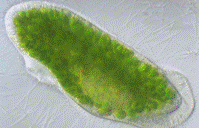Biological Sciences, School of

School of Biological Sciences: Faculty Publications
Document Type
Article
Date of this Version
2000
Citation
Ecology, 81(1), 2000, pp. 66–77
Abstract
For insect herbivores, population responses reflect interactions among multiple factors, including abiotic conditions, food plant availability, and biotic interactions guided by food limitation and natural enemies. In this set of field experiments, we evaluated the interactive, dynamic effects of limited food supply and predation from wolf spiders (Lycosidae) on mortality in Ageneotettix deorum, a common grasshopper (Acrididae) from North American sandhills grasslands. We attempted to determine whether the combined effects of food availability and spider predation on mortality were (1) noncompensatory, with the effects of each factor summing to determine ultimate population size, or (2) compensatory, where the effect of one mortality factor alters the impact of subsequent factors so that the ultimate population size changes little, despite variation in specific sources of mortality. We also investigated whether changes in nutritional quality encountered by grasshoppers would result in different dynamic responses to predation in the context of noncompensatory vs. compensatory responses.
Both food availability and predation risk contributed to mortality rates. Individuals of A. deorum were food limited. Survival of grasshoppers feeding on fertilized plants was 50% higher than that of grasshoppers feeding on unfertilized plants over a 31-d period. Most of the mortality due to limited food occurred 12–14 d into the experiment. Predation from lycosid spiders decreased the numbers of individuals by 49% in the first 10–15 days of the experiment.
Either noncompensatory or compensatory responses resulted from the combined effects of food availability and predation on population size, depending upon the nutritional status of host plants. At ambient-level food quality (no fertilizer), spider predation and food limitation were compensatory; the same numbers of grasshoppers were recovered in treatments with and without spider-predation risk after 31 d. However, with higher food quality (N fertilizer), spider predation reduced the numbers of surviving individuals as compared with the no-spider-predation treatment, a noncompensatory response. In separate, preplanned experiments, individuals surviving spider-predation treatments lived longer than did individuals protected from spider predation when they were caged individually over vegetation of ambient quality.
Combined, these experiments emphasize the importance of food quality as a determinant of how this predator–prey system responds, and the results suggest a mechanism underlying the response. After predation, survivors are likely to encounter more food per capita and to exhibit higher individual quality, which promotes longevity, presumably from reduced competition. This leads to a compensatory response. Under high food quality regimes, predation and food probably act in a noncompensatory fashion because grasshoppers are less food limited, and the release of additional food on a per capita basis by predation has less effect on the subsequent number of survivors.


Comments
Copyright 2000 by the Ecological Society of America